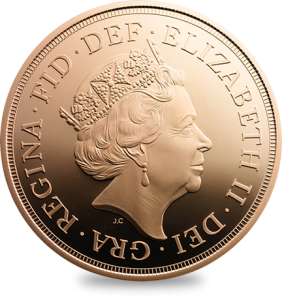The 2017 Gold Sovereign celebrates 200 years since the first ‘modern’ Sovereign was minted in the UK and is now available to purchase direct from The Royal Mint.
Sovereigns actually date back to 1489, when King Henry VII told the Royal Mint to produce a new high value gold coin or, as he described it, “a new money of gold”. Named the Sovereign, it had an ornate and elaborate design. The obverse naturally showed an image of King Henry himself on his throne, while the reverse marked the end of the Wars of the Roses between Lancaster and York, with a large double rose surrounding the royal coat of arms. This ostentatious coin was in every sense, a status symbol.
In 1817 the Sovereign was reborn as a gold coin with a nominal 20 shilling value. Though smaller and much lighter than the 1489 version, it was just as visually striking, introducing the renowned St George and dragon design created by Benedetto Pistrucci.
This design has come to be one of the most admired and revered of all those to grace the Sovereign. It has appeared on each gold sovereign minted for a new monarch, since the reign of Queen Victoria. So it’s entirely fitting that it should grace the 2017 Sovereign, which marks 200 years since the introduction of the ‘modern’ version of the coin.
[embedyt] http://www.youtube.com/watch?v=lU-HB9bm10Q[/embedyt]
How the modern Sovereign came about
The defeat of Napoleon at Waterloo saw the end of another costly war, in both human and monetary terms. It was the latter aspect particularly that contributed to a review of UK coinage, including adopting gold as the ‘Sole Standard Measure of Value’.
Had tradition been maintained, the Sovereign would have a 21 shilling guinea, but there was considerable pressure for 20 and 10 shilling gold coins, rather than the rather awkward values of Guineas, Half Guineas and Seven Shilling Pieces. The 20 shilling gold coin became the Sovereign and the 10 shilling gold coin, logically, the Half Sovereign.
Augmenting the Pistrucci design
Surrounding the St George and dragon around the edge of the 2017 Sovereign are the words Honi soit qui mal y pense. There are various translations of this Anglo-Norman phrase, but it’s generally taken to mean “Shame be to him who thinks evil of it”. The phrase is probably best known, certainly in the UK, as the motto of the Order of the Garter, which also appears on the Royal coat of arms.
As with the exact translation of the phrase, there are different versions of how it came about. Perhaps the most appealing is based on the story of King Edward III dancing with his cousin Joan of Kent. When her garter slipped down her leg, there were sniggers from those attending the dance. Edward promptly displayed his chivalry by attaching it to his own leg, saying “Honi soit qui mal y pense”, which was an admonishment to the courtiers meaning “a scoundrel who thinks badly of it.” And so was established the Order of the Garter, which is the highest order of chivalry bestowed in the UK, ranking as an honour only behind the George Cross and Victoria Cross.
Another notable feature
The 2017 Sovereign is the first Sovereign to actually show the year of its minting since the 1887 coin. This departure from recent tradition is, of course, to mark the 200th anniversary of the ‘modern’ Sovereign.
The Queen’s head
The obverse of the 2017 gold Sovereign shows Jody Clark‘s image of H.M. Queen Elizabeth II. His is the fifth depiction of the current Queen, who is now Britain’s longest-ever serving monarch and the world’s longest serving current monarch.
Jody Clark’s design was first seen in 2015. Then 33 years old, he was the youngest artist to have portrayed Elizabeth II for the Royal Mint.
‘The chief coin of the world’
Whilst perhaps conceived as a status symbol, the Gold Sovereign has become respected as a serious trading commodity and features widely on the world’s bullion markets.
This transformation largely came about with the new standards for accuracy established with the 1817 Sovereign. As well as Pistrucci’s landmark design, the Sovereign benefited from the precision of new, steam-driven minting machinery at the Royal Mint’s new London location in Tower Hill. This reputation for excellence has been upheld to the present day, making the British Gold Sovereign probably the world’s most recognised bullion coin.
The 2017 Gold Sovereign is struck from 22 carat gold, is 22.05mm or 0.868 inches diameter, and weighs 7.98g or 0.281 ounces. Buy it now from The Royal Mint.







